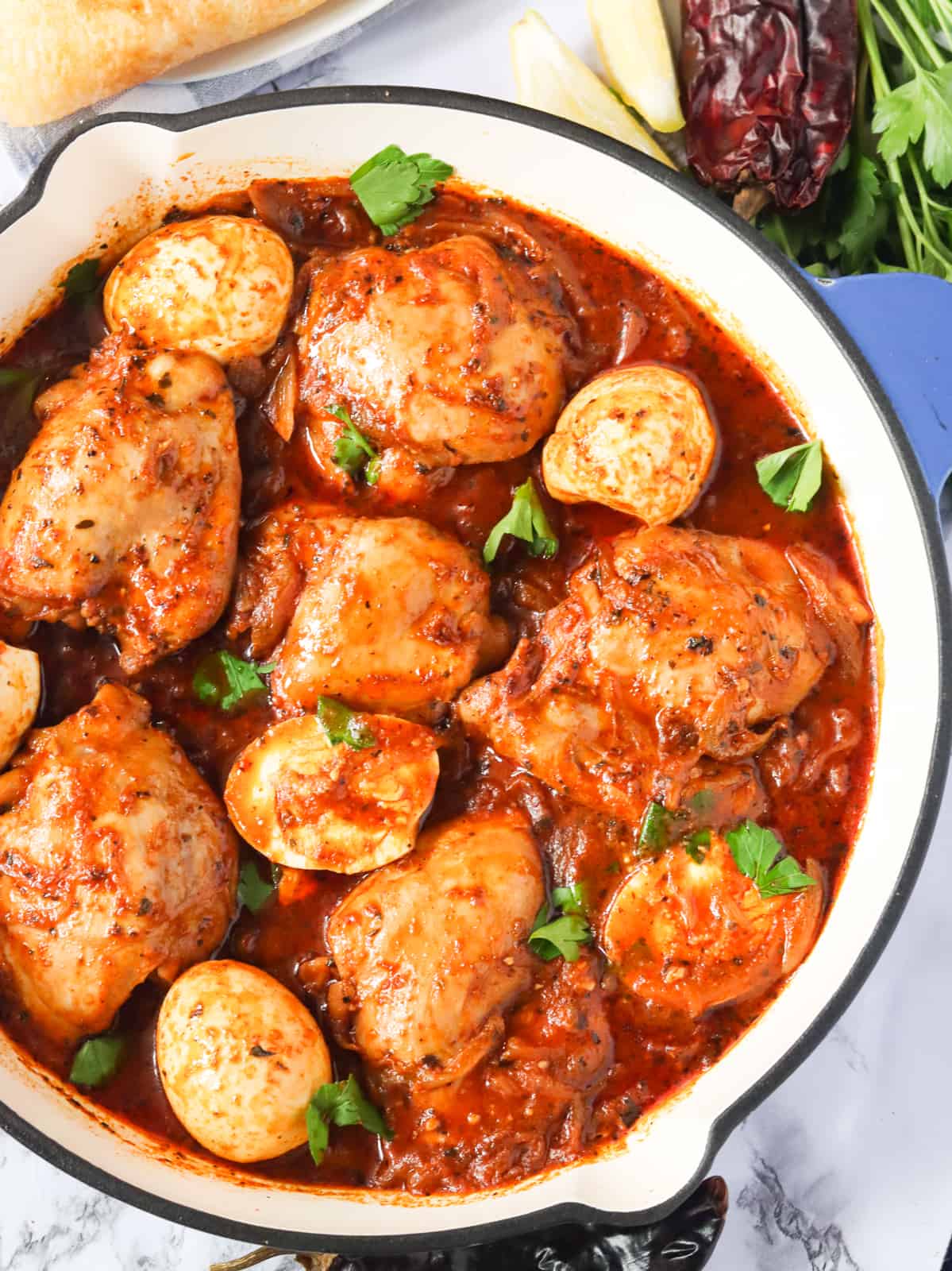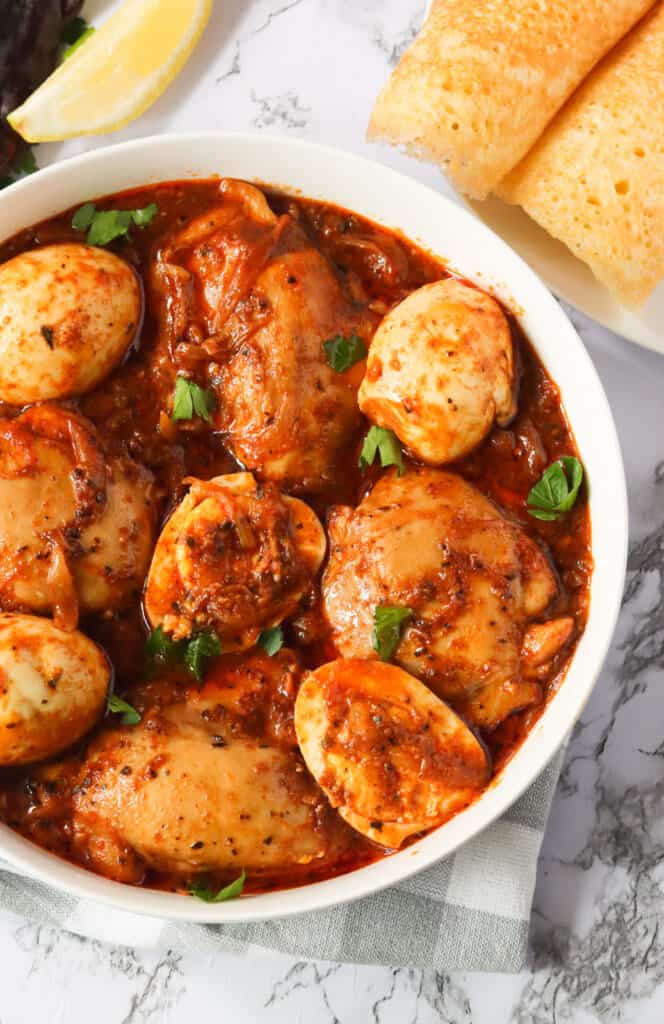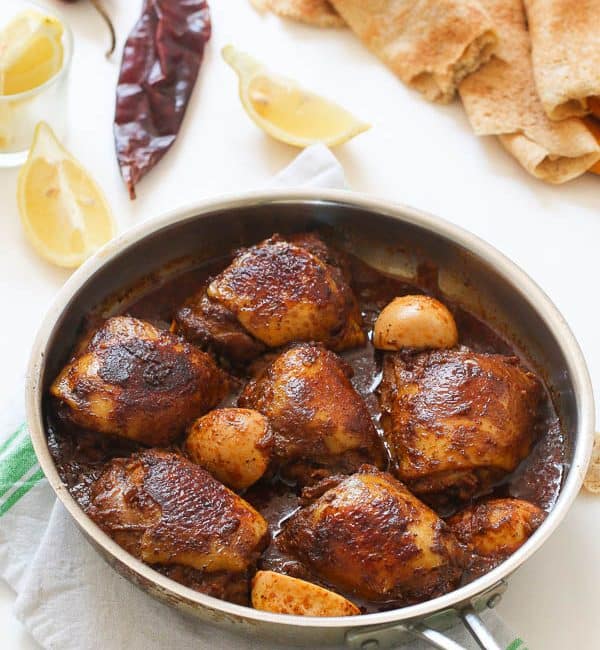Doro Wat Ethiopian Chicken Stew is a spicy, mouthwatering, and comforting one-pot dish slowly simmered in a blend of robust spices. This delightfully delicious chicken dinner is super easy! Pair it with injera and Ethiopian collard greens to complete your iconic Ethiopian experience.
I love salads and fresh produce that celebrate summer, but nothing comforts me like stews and casseroles, regardless of the weather. They always give me comforting soul-satisfying goodness like no other. And I have been happily craving Doro Wat for some time now.
So I’m ready to share my love of this stew with you guys. And if it’s the first time you’ve heard of this recipe, I’m telling you, it’s worth a try. All the complex flavors will surely give you an unforgettable Ethiopian experience in the comfort of your home. Oh yes!
Authentic Doro Wat
This version of Doro Wat, aka Doro Wot, is true to its roots. Plus, it’s easy to put together and packed with robust flavors from the spices. The berbere spice mix and Ethiopian spiced butter add dimension to the dish and incredible depth of flavor. And oh, the caramelized onion packs a drool-worthy punch. It does indeed!!!!
Folks! This spicy Ethiopian chicken stew is African comfort food at its best. If you want a great introduction to Ethiopian cooking, this is it!
Recipe Ingredients
Some of the ingredients may be new to you but don’t worry because I’ve got you covered with homemade spice mixes. Your girl is looking out for you! So not having an Ethiopian market next door won’t slow you down.
- Chicken – Traditionally, a whole chicken cut into 12 pieces is used in this Ethiopian dish to represent the 12 tribes of Jacob (from the Bible). But feel free to use any cut of chicken you prefer. 😉
- Aromatics – Take your time sauteing the onion, garlic, ginger, and the unique blend of spices from the Ethiopian spiced butter. This allows them to fully release their delectable savory goodness that will indeed reflect our sauce base. Yum!
- Boiled Eggs – You can’t go wrong with adding more protein. Let them simmer with the sauce for a more effective flavor absorption.
- Tomato Paste – Besides adding a rich tanginess, it also adds a lovely deep reddish hue to our spicy chicken stew.
- Seasonings – Berbere spice is the key ingredient in this recipe. It holds different flavors from a diverse blend of spices, such as cinnamon, nutmeg, fenugreek, cardamom, and cumin, giving our stew its authentic taste. I also added more paprika and basil to deepen the flavor.
- Lemon – The lemon juice somewhat gives our dish a refreshing zing and balances the fat in the spiced butter.
How to Make Doro Wat
Saute the Aromatics
- Prep the Chicken – Season chicken with salt and pepper, and set aside.
- Saute – Heat a large pot over medium heat until hot, then add the spiced butter and onions. Sauté onions, frequently stirring, until they are deep brown – 7-10 minutes. (Photos 1-2)
- Add Berbere Spice – After the onions are caramelized or reach a deep brown color, add some more oil, followed by the berbere spice, garlic, and ginger. (Photo 3)
- Continue Stirring – Stir for about 2-3 minutes for the flavors to blossom, and the mixture has a deep rich brown color. Be careful not to let it burn. (Photo 4)
Make the Stew
- Add Water – Then add about 2-3 cups of water. Add chicken, tomato paste, paprika, basil, and salt, and cook for about 30 minutes.
- Then Eggs – Throw in the eggs and lemon juice; thoroughly mix to ensure that the eggs are immersed in the sauce.
- Simmer – Continue cooking until chicken is tender, 10 minutes or more.
- Adjust Seasoning – Adjust sauce thickness and seasoning with water or broth, lemon, and salt according to preference.
- Serve warm.
Recipe Variations
- Meat Options – Another version you’ll love is Sega Wat, which is made with beef instead of chicken. But if you’re not after the authenticity, feel free to substitute the chicken with pork or seafood, like fish, shrimp, squid, mussels, and scallops. Oh yes!
- Veggie Additions – Make this delicious stew even more filling and nourishing by adding veggies, like carrots, potatoes, squash, bell peppers, and celery. Fantastic! Or try a vegetarian version – Zucchini Wat and Ethiopian Lentil Stew.
- Spicier – You can always add more pepper flakes and cayenne if you feel it’s not spicy enough. Or ramp up the heat with serrano, habanero, jalapeno, or Scotch bonnet peppers for an irresistible mouthful of smoking sassiness.
Tips and Tricks
- Instead of water, you can also use chicken broth to add more umami flavor. But go gentle on the salt as the broth already has salt.
- The longer you saute the aromatics, the better. Because sauteing releases the natural savory flavor of the aromatics as the onion caramelizes. But this requires frequent stirring to prevent them from scorching at the bottom of the pan.
- If you don’t have spiced butter, either make your own blend or saute the aromatics in butter instead. Then add allspice, cardamon, cumin, cinnamon, and nutmeg to compensate for the missing flavors.
Make-Ahead Instructions
Stews are usually served on the same day because you can hardly resist them (admit it!), but they are actually better the next day, like this yummy Doro Wat here. Time allows all the flavor to settle in and seep into the fibers of the chicken, giving you a more soul-satisfying deliciousness with every bite.
The good news is that you just need to cook it as instructed and store it in the fridge once cooled. And when you are ready to serve, warm it up again and enjoy. 😉
Serving and Storing Instructions
To fully immerse in Ethiopian cuisine, I suggest eating this succulent Doro Wat with injera, a crepe-like flatbread made with cornflour, sorghum, flour, yeast, and baking soda. I’m telling you, no bowls will be left dirty because you’ll be wiping them clean with this utterly addicting injera. 😉
Storing Doro Wot is as easy as transferring it to an airtight container. Once cooled, refrigerate it for up to four days. Or, if you intend to save it for later, you can also store it in the freezer for 4-6 months. I suggest keeping it in a heavy-duty freezer-safe resealable bag to save freezer space, but an airtight container will also work fine. 😉
FAQs
Doro Wat is chicken, boiled eggs, tomato paste, and seasonings. What differentiates this Ethiopian chicken stew from the other stews is the Berbere spices that give it an authentic flavor. But don’t sweat it if you can’t find it in your local grocery stores; you can just make your own with a mix of paprika, basil, cumin, curry, cardamom, pepper flakes, cinnamon, and nutmeg.
I didn’t use fresh tomatoes in my recipe, but I did use tomato paste. I prefer it over fresh tomatoes because it concentrates the flavor more, thickens the sauce, and adds a lovely vibrant red color. But, of course, if you want to use fresh tomatoes, then go for it. And if it gets too watery, you can add a thickener like cornstarch slurry.
The traditional Doro Wat recipe uses a whole chicken, which is then cut into 12 pieces. But, of course, you can always use any cut of chicken you like. I prefer chicken thighs because they’re tastier.
What to Serve with Doro Wat
Aside from injera and rice, you can also complete your sensory vacation to Ethiopia with these recipes below.
You can also enjoy our stew with these bread recipes to clean your bowl.
More Amazing Stew Recipes to Try
Conclusion
Doro Wat makes a mouthwatering starter if you are new to Ethiopian cuisine. Are you hungry for more delicious African dishes? Then subscribe to my newsletter for more fabulous recipes like this. ❤️
Watch How to Make It
[adthrive-in-post-video-player video-id=”SZQBn7je” upload-date=”2022-06-14T12:01:17.000Z” name=”DORO WAT.mp4″ description=”Doro Wat Ethiopian Chicken Stew is a spicy, mouthwatering, and comforting one-pot dish slowly simmered in a blend of robust spices. ” player-type=”collapse” override-embed=”false”]
This blog post was originally published in October 2015 and has been updated with additional tips, new photos, and a video.
Doro Wat Ethiopian Chicken Stew
Ingredients
- 3-3½ pounds (1.3-1.6kg) chicken, cut in pieces (or chicken thighs)
- 3 tablespoons (42g) spiced butter, or more (sub with cooking oil)
- 2-3 medium onions, sliced
- ¼ cup (60ml) canola oil
- 2 tablespoons (2g) Berbere spice
- 1 tablespoon (9g) garlic, minced
- ½ tablespoon (4.5g) ginger, minced
- 2-3 cups (473-709ml) water
- 1 tablespoon (14g) tomato paste
- ½ tablespoon (.5g) paprika
- 1 tablespoon (2g) dried basil, optional
- 4-6 large eggs, soft boiled and shells removed
- 1-2 lemons, freshly squeezed (adjust to taste)
- Salt and pepper to taste
Instructions
- Season chicken with, salt, and pepper. Set aside.
- Heat a large pot over medium heat, and when it's hot, add spiced butter and onions. Sauté onions, stirring frequently, until they are deep brown – 7-10 minutes.
- After the onions are caramelized or reach a deep brown color, add some more oil, followed by the Berbere spice, garlic, and ginger.
- Stir for about 2-3 minutes for the flavors to blossom and the mixture has a deep rich brown color. Be careful not to let it burn.
- Then add about 2-3 cups water. Add chicken, tomato paste, paprika, basil, salt, and cook for about 30 minutes.
- Throw in the eggs and lemon juice; thoroughly mix to ensure that the eggs are immersed in the sauce.
- Continue cooking until chicken is tender about 10 minutes or more.
- Adjust sauce thickness and seasoning with water or broth, lemon, salt according to preference.
- Serve warm.
Tips & Notes:
- Instead of water, you can also use chicken broth to add more umami flavor to the stew. But go gentle on the salt as the broth already has salt.
- The longer you saute the aromatics, the better, because sauteing releases the natural savory flavor of the aromatics as the onion caramelizes. But this requires frequent stirring to prevent them from scorching at the bottom of the pan.
- If you don’t have spiced butter, either make your own blend or saute the aromatics in butter instead. Then add allspice, cardamon, cumin, cinnamon, and nutmeg to compensate for the missing flavors.
- Please keep in mind that the nutritional information is a rough estimate and can vary significantly based on the products used in the recipe.








Sujata nair says
This recipe is awesome
Imma says
You are so sweet, thank you!
Klove says
Authentic or not but I am loving this recipe. By far the best chicken stew I ever had so far in my life. I could eat this everyday if family would be willing and maybe just vary the type of protein used. The lemon juice adds a final special touch. Made this chicken twice already with the Ethiopian greens and the 2nd time made it with the cabbage recipe you have served with white rice. I was in heaven. Thanks’ Imma.
Imma says
You are more than welcome. And if there’s a recipe you’d love to see, please let me know. Thanks:)
Kristy K says
Thanks for this recipe! Should the skin be removed before cooking?
Imma says
It’s a personal decision. I prefer to remove the skin because it gets soggy.
Christina says
This is one of my all time favorite recipes! It can be tough to make it to an Ethiopian restaurant where I live, so this is super helpful 🙂
Amina says
Thank you for trying this recipe. Happy to hear your story, Stay tuned for more amazing recipes.
Alexis S says
I’ve been making this recipe for several years now, and I absolutely love it. I never change anything, and I serve it with the Ethiopian greens and injera.
ImmaculateBites says
Nice nice! Injera is one of the blockbusters here at home, lol!
Connie Foster says
This looks fairly easy and I’m looking forward to cooking it. Please add me to your mailing list so I can enjoy more of these fabulous recipes. Thanks.